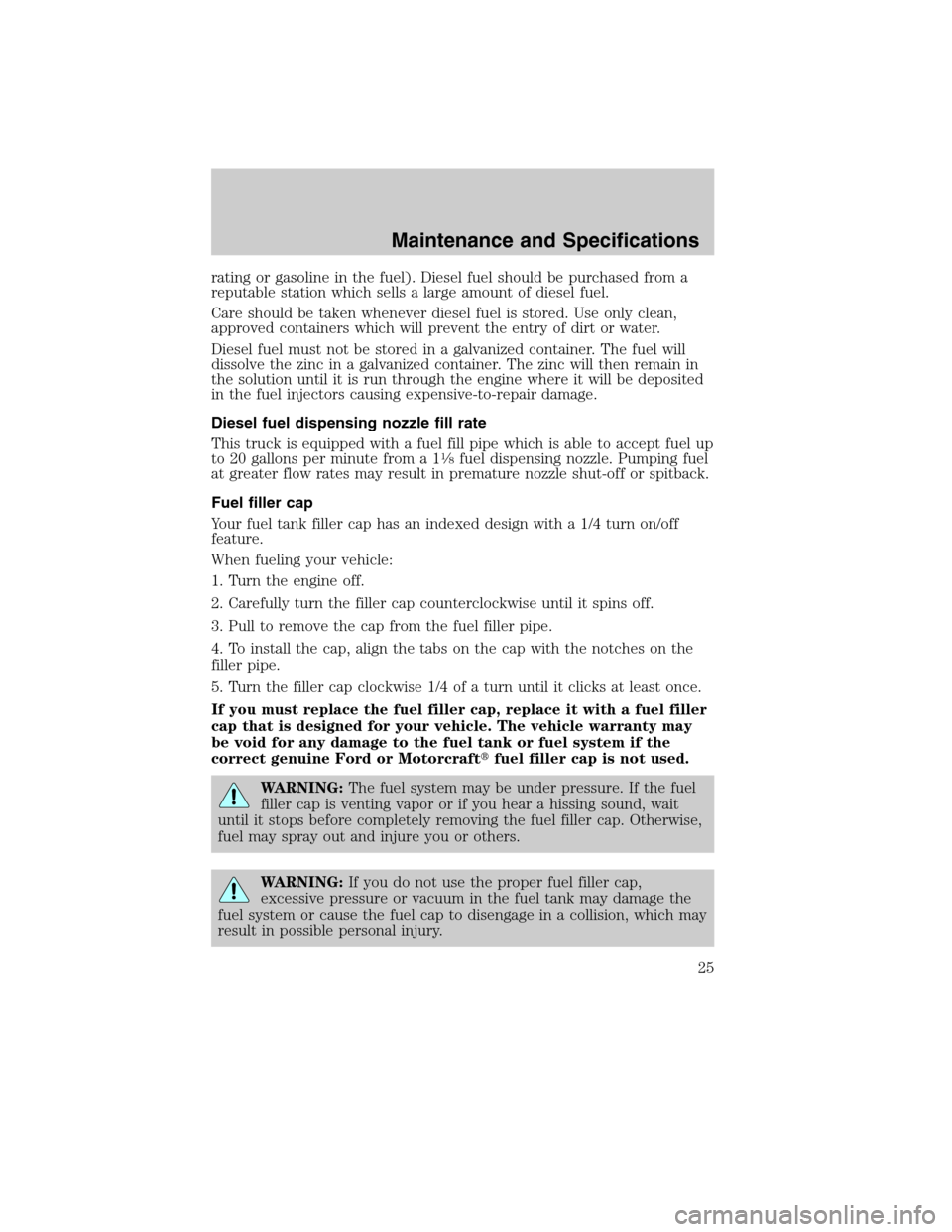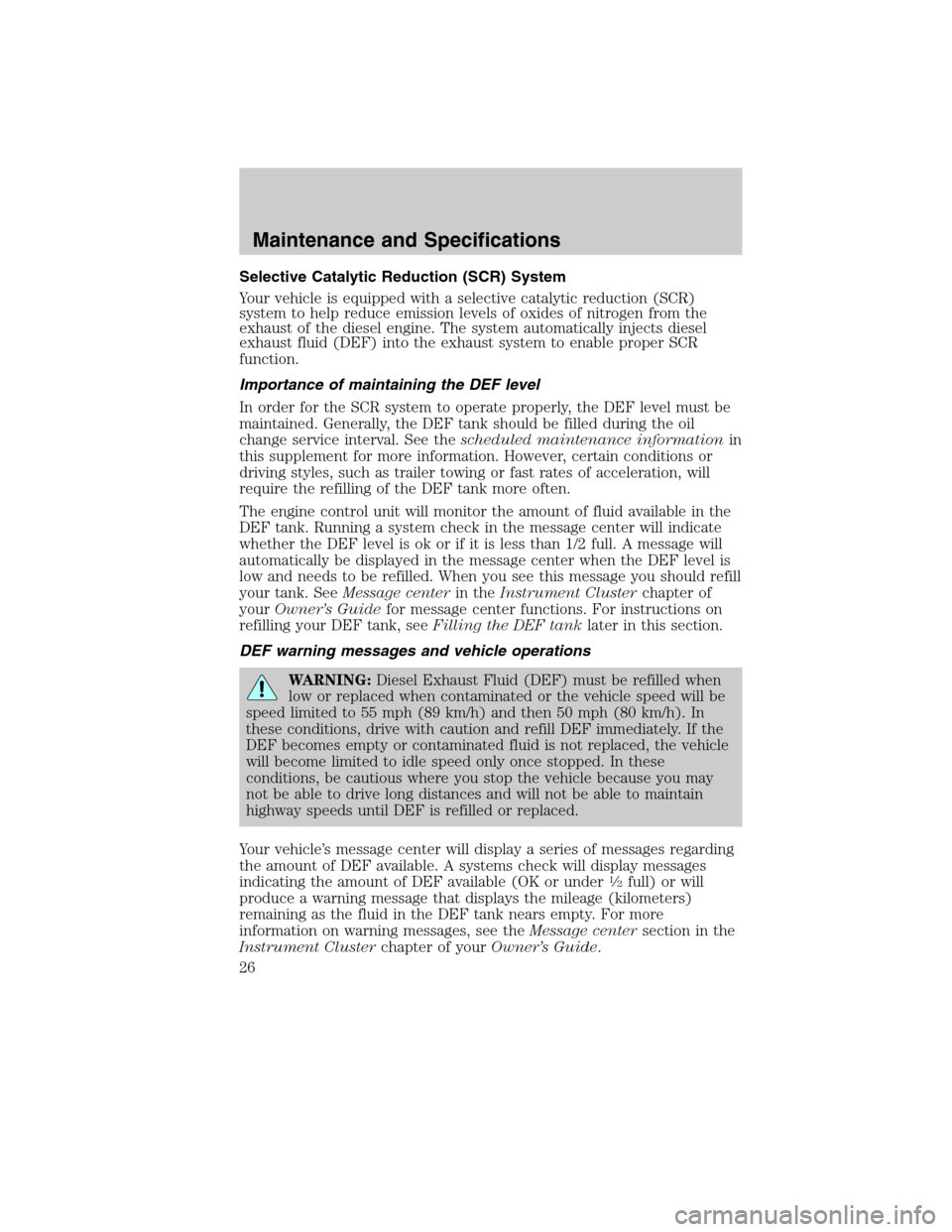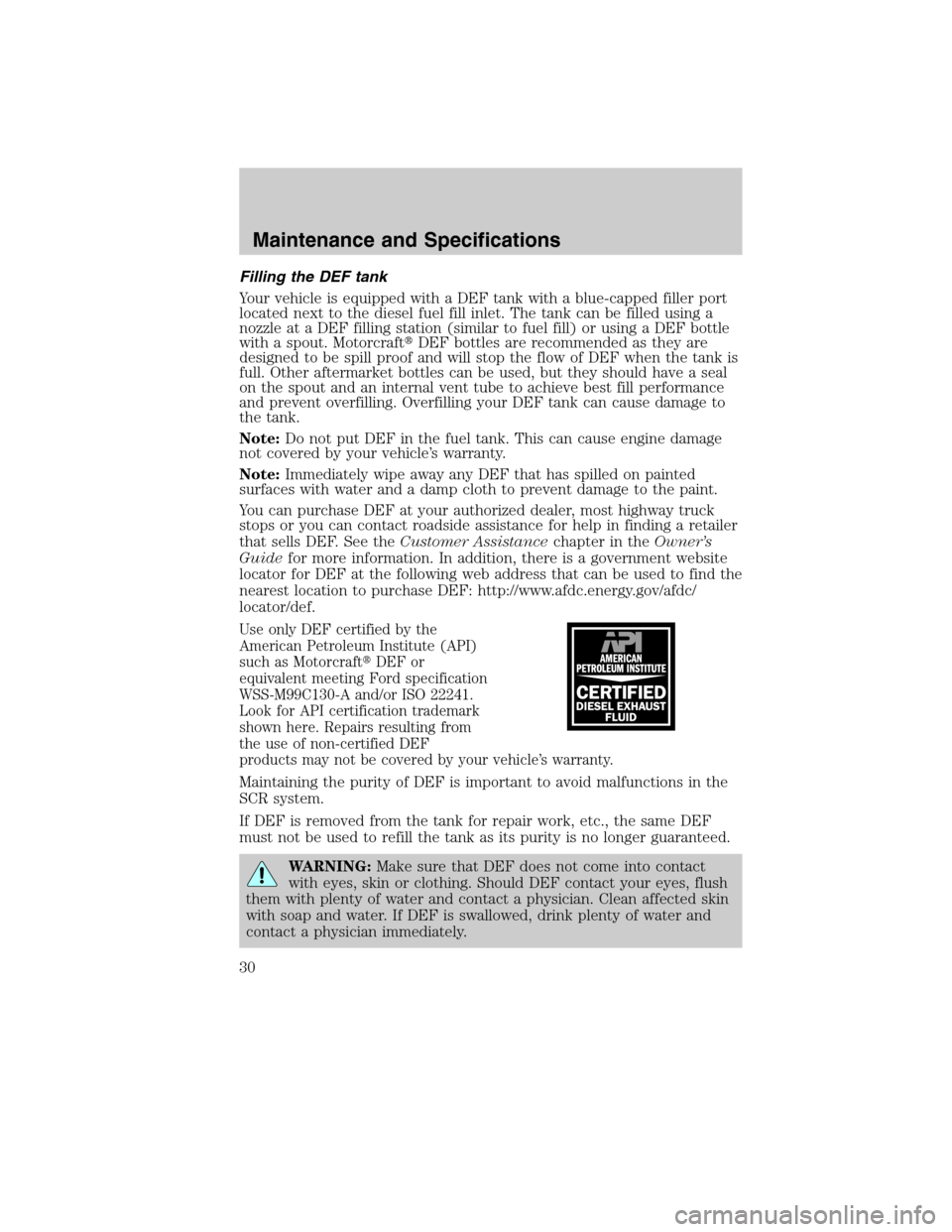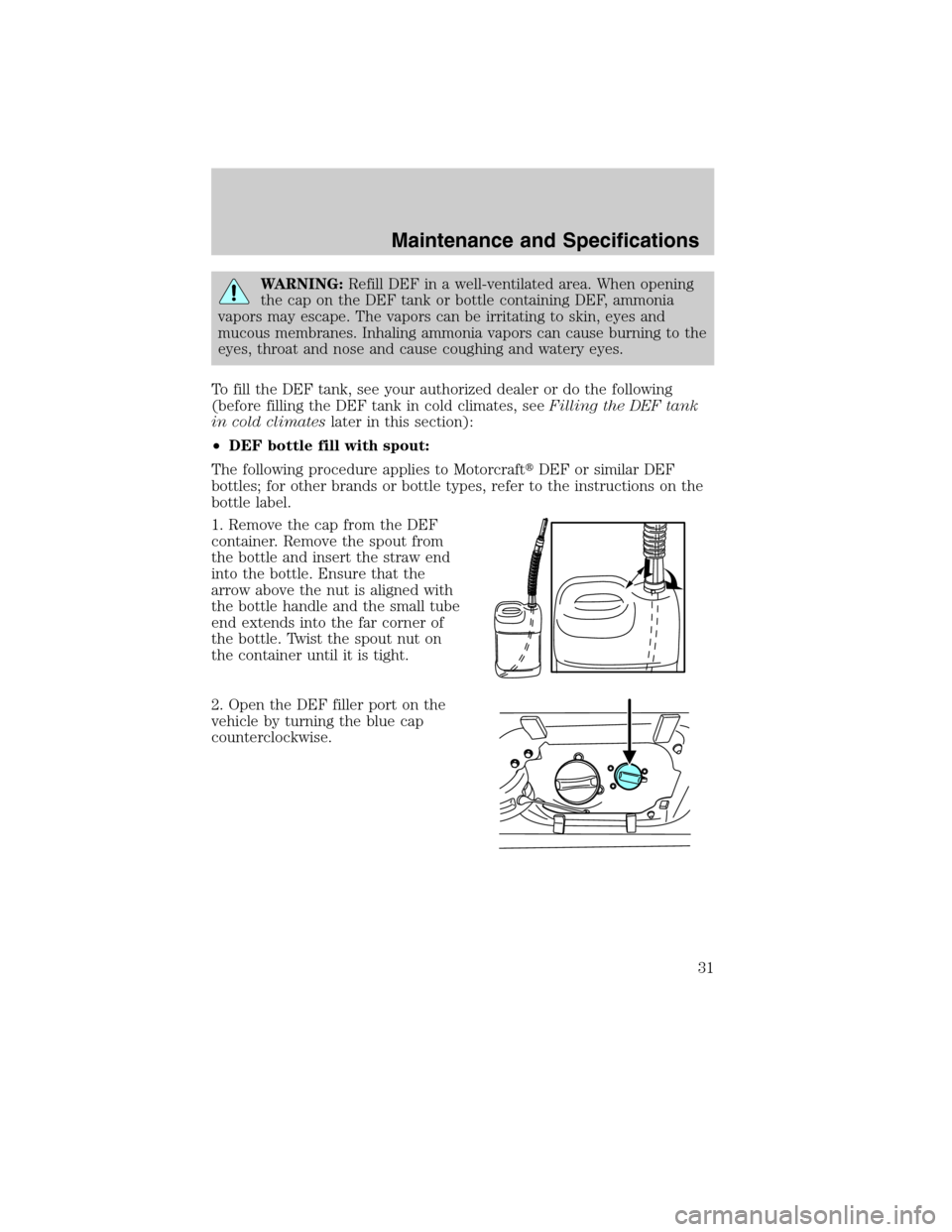Page 25 of 90

rating or gasoline in the fuel). Diesel fuel should be purchased from a
reputable station which sells a large amount of diesel fuel.
Care should be taken whenever diesel fuel is stored. Use only clean,
approved containers which will prevent the entry of dirt or water.
Diesel fuel must not be stored in a galvanized container. The fuel will
dissolve the zinc in a galvanized container. The zinc will then remain in
the solution until it is run through the engine where it will be deposited
in the fuel injectors causing expensive-to-repair damage.
Diesel fuel dispensing nozzle fill rate
This truck is equipped with a fuel fill pipe which is able to accept fuel up
to 20 gallons per minute from a 1
1�8fuel dispensing nozzle. Pumping fuel
at greater flow rates may result in premature nozzle shut-off or spitback.
Fuel filler cap
Your fuel tank filler cap has an indexed design with a 1/4 turn on/off
feature.
When fueling your vehicle:
1. Turn the engine off.
2. Carefully turn the filler cap counterclockwise until it spins off.
3. Pull to remove the cap from the fuel filler pipe.
4. To install the cap, align the tabs on the cap with the notches on the
filler pipe.
5. Turn the filler cap clockwise 1/4 of a turn until it clicks at least once.
If you must replace the fuel filler cap, replace it with a fuel filler
cap that is designed for your vehicle. The vehicle warranty may
be void for any damage to the fuel tank or fuel system if the
correct genuine Ford or Motorcraft�fuel filler cap is not used.
WARNING:The fuel system may be under pressure. If the fuel
filler cap is venting vapor or if you hear a hissing sound, wait
until it stops before completely removing the fuel filler cap. Otherwise,
fuel may spray out and injure you or others.
WARNING:If you do not use the proper fuel filler cap,
excessive pressure or vacuum in the fuel tank may damage the
fuel system or cause the fuel cap to disengage in a collision, which may
result in possible personal injury.
Maintenance and Specifications
25
2011 Econoline(eco)
Supplement, 1st Printing
USA(fus)
Page 26 of 90

Selective Catalytic Reduction (SCR) System
Your vehicle is equipped with a selective catalytic reduction (SCR)
system to help reduce emission levels of oxides of nitrogen from the
exhaust of the diesel engine. The system automatically injects diesel
exhaust fluid (DEF) into the exhaust system to enable proper SCR
function.
Importance of maintaining the DEF level
In order for the SCR system to operate properly, the DEF level must be
maintained. Generally, the DEF tank should be filled during the oil
change service interval. See thescheduled maintenance informationin
this supplement for more information. However, certain conditions or
driving styles, such as trailer towing or fast rates of acceleration, will
require the refilling of the DEF tank more often.
The engine control unit will monitor the amount of fluid available in the
DEF tank. Running a system check in the message center will indicate
whether the DEF level is ok or if it is less than 1/2 full. A message will
automatically be displayed in the message center when the DEF level is
low and needs to be refilled. When you see this message you should refill
your tank. SeeMessage centerin theInstrument Clusterchapter of
yourOwner’s Guidefor message center functions. For instructions on
refilling your DEF tank, seeFilling the DEF tanklater in this section.
DEF warning messages and vehicle operations
WARNING:Diesel Exhaust Fluid (DEF) must be refilled when
low or replaced when contaminated or the vehicle speed will be
speed limited to 55 mph (89 km/h) and then 50 mph (80 km/h). In
these conditions, drive with caution and refill DEF immediately. If the
DEF becomes empty or contaminated fluid is not replaced, the vehicle
will become limited to idle speed only once stopped. In these
conditions, be cautious where you stop the vehicle because you may
not be able to drive long distances and will not be able to maintain
highway speeds until DEF is refilled or replaced.
Your vehicle’s message center will display a series of messages regarding
the amount of DEF available. A systems check will display messages
indicating the amount of DEF available (OK or under
1�2full) or will
produce a warning message that displays the mileage (kilometers)
remaining as the fluid in the DEF tank nears empty. For more
information on warning messages, see theMessage centersection in the
Instrument Clusterchapter of yourOwner’s Guide.
Maintenance and Specifications
26
2011 Econoline(eco)
Supplement, 1st Printing
USA(fus)
Page 27 of 90

As the DEF level nears empty, the
DEF warning symbol will be
displayed and chimes will sound
with the messages starting at
300 miles (483 km) remaining
before DEF is depleted. The
warning symbol and messages will
continue until the DEF tank is
refilled.
Continued driving without refilling will result in the following actions as
required by the U.S. Environmental Protection Agency (EPA):
•Within a certain number of miles (kilometers) to empty, speed will be
limited upon vehicle restart. Prior to this occurring a message will
appear in the message center.
•Further vehicle operation without refilling your DEF tank will cause
the engine to enter an idle-only condition. This will only occur upon
vehicle refueling and will be indicated by a message in the message
center indicating required actions to resume normal operation. It is
required to add a minimum of 0.5 gallons (1.9L) of DEF to the tank to
exit the idle-only condition, but the vehicle will still be in the speed
limiting mode until the tank is refilled.
For either vehicle speed limiting or idle-only condition, normal vehicle
operation will resume when the DEF tank is refilled.
Note:When filling the DEF tank from empty, there may be a short delay
before detecting the increased level of DEF. This must occur before full
power is returned.
Maintenance and Specifications
27
2011 Econoline(eco)
Supplement, 1st Printing
USA(fus)
Page 28 of 90
Low DEF Warnings and Actions — Instrument Cluster Messages (Optional message
center messages shown, base message center messages similar)
Distance/DEF Level
or ActionCluster MessageCustomer Requested
ActionsVehicle Actions
Full TankExhaust Fluid
Level OKDrive normally None
Below
1�2TankExhaust Fluid
Under
1�2FullDrive normally None
800 Miles (1287 km)Exhaust Fluid
Range 800 miles
(1287 km)Refill exhaust fluid None
300 Miles (483 km)Exhaust Fluid
Range 300 miles
(483 km)Refill exhaust fluid None
99 Miles (159 km)In 99 Miles
(159 km) Speed
Limited to
55 MPH (89 km/h)
Exhaust Fluid
EmptyRefill exhaust fluid None
*0 Miles (0 km)Speed Limited to
55 MPH (89 km/h)
Max Upon Restart
Exhaust Fluid
EmptyRefill exhaust fluid None
Maintenance and Specifications
28
2011 Econoline(eco)
Supplement, 1st Printing
USA(fus)
Page 29 of 90
Low DEF Warnings and Actions — Instrument Cluster Messages (Optional message
center messages shown, base message center messages similar)
Distance/DEF Level
or ActionCluster MessageCustomer Requested
ActionsVehicle Actions
RestartSpeed Limited To
55 MPH (89 km/h)
Exhaust Fluid
emptyRefill exhaust fluid
On vehicle restart, speed
is limited to 55 MPH.
(89 km/h
*No action occurs until
restart.
*200 Miles (322 km)In 200 Miles
(322 km) Speed
Limited to
50 MPH (80 km/h)
Exhaust Fluid
EmptyRefill exhaust fluid
RestartSpeed Limited To
50 MPH (80 km/h)
Exhaust Fluid
EmptyRefill exhaust fluidOn vehicle restart, speed
is limited to 50 MPH
(80 km/h).
**No action taken until
vehicle is refueled
**100 Miles (161 km)Engine Idled Upon
Refuel Exhaust
Fluid EmptyRefill exhaust fluid
Diesel Tank FillEngine Idled-See
Owner’s Manual
Exhaust Fluid
EmptyRefill exhaust fluidEngine limited to idle
ONLY
Maintenance and Specifications
29
2011 Econoline(eco)
Supplement, 1st Printing
USA(fus)
Page 30 of 90

Filling the DEF tank
Your vehicle is equipped with a DEF tank with a blue-capped filler port
located next to the diesel fuel fill inlet. The tank can be filled using a
nozzle at a DEF filling station (similar to fuel fill) or using a DEF bottle
with a spout. Motorcraft�DEF bottles are recommended as they are
designed to be spill proof and will stop the flow of DEF when the tank is
full. Other aftermarket bottles can be used, but they should have a seal
on the spout and an internal vent tube to achieve best fill performance
and prevent overfilling. Overfilling your DEF tank can cause damage to
the tank.
Note:Do not put DEF in the fuel tank. This can cause engine damage
not covered by your vehicle’s warranty.
Note:Immediately wipe away any DEF that has spilled on painted
surfaces with water and a damp cloth to prevent damage to the paint.
You can purchase DEF at your authorized dealer, most highway truck
stops or you can contact roadside assistance for help in finding a retailer
that sells DEF. See theCustomer Assistancechapter in theOwner’s
Guidefor more information. In addition, there is a government website
locator for DEF at the following web address that can be used to find the
nearest location to purchase DEF: http://www.afdc.energy.gov/afdc/
locator/def.
Use only DEF certified by the
American Petroleum Institute (API)
such as Motorcraft�DEF or
equivalent meeting Ford specification
WSS-M99C130-A and/or ISO 22241.
Look for API certification trademark
shown here. Repairs resulting from
the use of non-certified DEF
products may not be covered by your vehicle’s warranty.
Maintaining the purity of DEF is important to avoid malfunctions in the
SCR system.
If DEF is removed from the tank for repair work, etc., the same DEF
must not be used to refill the tank as its purity is no longer guaranteed.
WARNING:Make sure that DEF does not come into contact
with eyes, skin or clothing. Should DEF contact your eyes, flush
them with plenty of water and contact a physician. Clean affected skin
with soap and water. If DEF is swallowed, drink plenty of water and
contact a physician immediately.
Maintenance and Specifications
30
2011 Econoline(eco)
Supplement, 1st Printing
USA(fus)
Page 31 of 90

WARNING:Refill DEF in a well-ventilated area. When opening
the cap on the DEF tank or bottle containing DEF, ammonia
vapors may escape. The vapors can be irritating to skin, eyes and
mucous membranes. Inhaling ammonia vapors can cause burning to the
eyes, throat and nose and cause coughing and watery eyes.
To fill the DEF tank, see your authorized dealer or do the following
(before filling the DEF tank in cold climates, seeFilling the DEF tank
in cold climateslater in this section):
•DEF bottle fill with spout:
The following procedure applies to Motorcraft�DEF or similar DEF
bottles; for other brands or bottle types, refer to the instructions on the
bottle label.
1. Remove the cap from the DEF
container. Remove the spout from
the bottle and insert the straw end
into the bottle. Ensure that the
arrow above the nut is aligned with
the bottle handle and the small tube
end extends into the far corner of
the bottle. Twist the spout nut on
the container until it is tight.
2. Open the DEF filler port on the
vehicle by turning the blue cap
counterclockwise.
Maintenance and Specifications
31
2011 Econoline(eco)
Supplement, 1st Printing
USA(fus)
Page 32 of 90
3. Lift and hold the DEF container,
without tipping, and insert the spout
into the DEF filler port until the
small black seal on the spout is
completely seated into the DEF
filler port.
4A. While filling, the fluid level in
the bottle will continually drop.
4B. When the DEF tank is full, the
fluid level in the bottle will stop
dropping, indicating the fluid has
stopped flowing.
Maintenance and Specifications
32
2011 Econoline(eco)
Supplement, 1st Printing
USA(fus)